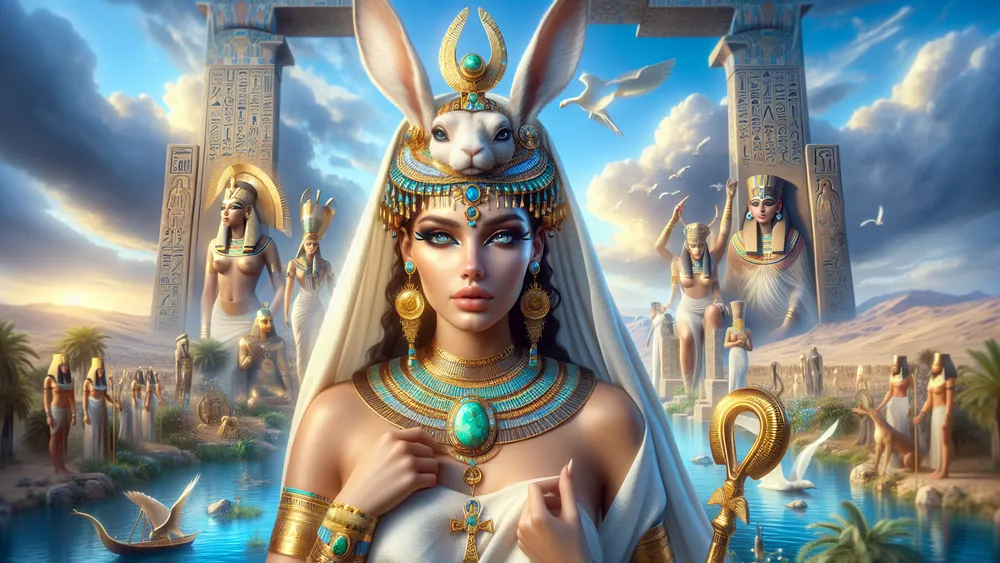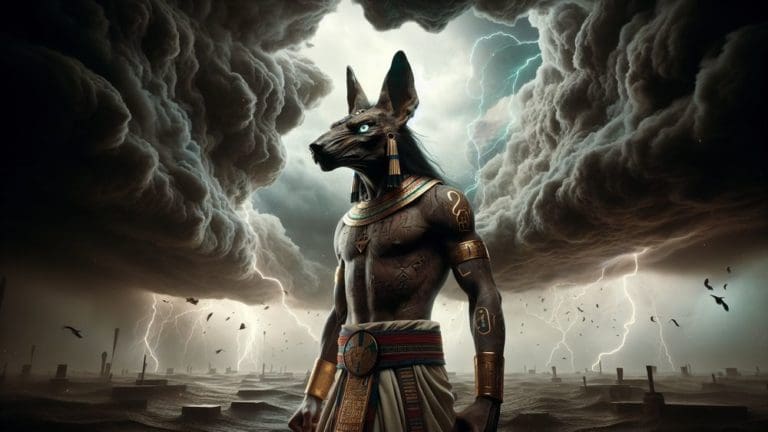Wenut: Ancient Egyptian Goddess Of Fertility And New Birth
As we look into the interesting world of Wenut, who is the ancient Egyptian deity of birth and new life, you will find out about her beginnings, importance, and ways she was respected in history.
Key Points:
- Wenut is an ancient Egyptian goddess linked to fertility, new birth, and the moon.
- She was part of the Ogdoad group of eight first gods in Hermopolis.
- Wenut was often represented as a hare or a woman with a hare’s head, symbolizing new life and birth.
- Worship of Wenut included offerings of food, drink, and items related to birth during the Old and Middle Kingdoms.
- She was mentioned in Pyramid Texts and Coffin Texts, emphasizing her role in fertility and protection.
- Wenut’s connection to the moon and time was crucial, influencing farming cycles and human birth.
- Today, Wenut is still respected in modern pagan practices and is featured in media and literature as a symbol of growth and change.
Wenut: Overview and Key Facts
| Important Point | Things to Know |
|---|---|
| Name | Wenut (also said Wenet or Unut) |
| Role | Deity of new birth, birth, and the moon |
| Meaning | Hare, moon |
| Place from | Ancient Egyptian stories |
| City Linked With | Hermopolis |
| Group Involved | Ogdoad |
| Looks | Show her like a hare or woman having a hare’s head |
| Worship Time | Mostly during the Old and Middle Times |
| Key Words | Talked about in Pyramid Texts and Coffin Texts |
| Things People Gave | Included gifts of food, drink, and things related to birth |
| Today’s Meaning | Looked up to in some new pagan practices and shown in today’s media |
Where Wenut Comes From and Her Story Through Time
To go back to long ago Egypt, we will find out about the start and changes of Wenut. You will see how she was seen and respected during the different times.
Wenut’s Mythical Beginnings
Wenut’s start in old Egyptian stories is tied to the religious ways of Hermopolis. A place known for having the Ogdoad, a group of eight first gods. These gods were the main parts of making the world, and Wenut was often with this strong group. Often, they showed Wenut as a hare or a woman with a hare’s head.
This meaning was about birth and new life. The hare, due to its quick making of new hares, made Wenut a clear sign for these ideas. Worship of Wenut had many practices and gifts, often about the planting seasons and making children. Here are some key points about her early worship.

- Link to Hermopolis: Wenut was tied to this city, which was a major religious spot.
- Tied to the Ogdoad: She was part of this group, eight gods meaning creation.
- Early Looks: Often shown as a hare or woman with hare’s head, showing her role in new birth.
- Worship Ways: Had gifts and practices linked to planting and human birth.
Wenut’s significance lies in her association with the Ogdoad, her representation as a hare symbolizing birth and new life, and her worship rituals linked to planting seasons and fertility.
Wenut in Old Egyptian Writings
Wenut is mentioned in a few ancient Egyptian writings, which give useful information about her role and importance. One of the first times Wenut is mentioned is in the Pyramid Writings, where religious spells and words were carved into pyramid walls during the Old Kingdom. These writings often call upon Wenut about fertility and keeping safe, showing her importance in making sure the land and its people do well.
And, the Coffin Writings, coming after the Pyramid Writings in the Middle Kingdom, also talk about Wenut, showing she remained important in religious actions. These words often show Wenut as a protector of the dead, making sure they safely go to the afterlife.
Over time, how people showed Wenut changed, which shows changes in beliefs and practices. In the New Kingdom, Wenut’s pictures became more detailed, often showing how she connected to the moon and time. This time saw more focus on her role in controlling moon cycles, which were important for planning planting and holding religious festivals. Here are some key points to help understand her changing picture:
- Pyramid Writings: Early mentions of Wenut in terms of fertility and protection.
- Coffin Writings: Still important as the protector of the dead.
- New Kingdom Pictures: More detailed pictures show her link to the moon and time.
- Changes in Worship: Show how beliefs and practices shifted over time.
Wenut’s Traits and What She Represents
Now, let’s look into the special qualities of Wenut and see what she means in old Egyptian stories.
Wenut: The Hare Goddess
In old Egyptian times, the hare meant life and new beginnings. This is mostly because hares can have lots of babies, which made it a good sign for life and starting again. Wenut, shown often as a hare or a woman with a hare’s head, shows these special qualities.
The hare in her pictures highlights her role as a goddess of fertility and new life. Like a hare can have lots of new ones in a short time, Wenut was believed to have the power to bring new life and make sure the land and its people did well. This made her a significant god in the farm-based life of old Egypt, where growing things and having children were vital.
Wenut’s pictures as a hare also appear in many stories, making her important in Egyptian stories. One story talks about Wenut helping to protect the sun god Ra on his nightly trip through the underworld. In this story, Wenut’s sharp senses and quick moves, traits of the hare, help her find and fight off threats to Ra. This story shows not just her role in life and birth, but also her protective side. For a better view, here are some key points about Wenut as the hare goddess:

- Sign of Life: The hare’s ability to have lots of babies made it a sign of life and starting again.
- Pictures: Often shown as a hare or a woman with a hare’s head, showing her role in fertility.
- Stories: Part of stories like guarding the sun god Ra on his trip through the underworld.
- Protective Side: Her picture as a hare also shows her role as a protector.
Wenut’s Connection to Growth and New Life
Wenut’s link to fertility and new life is based on her role as a goddess who watches over the cycles of life and renewal. In old Egyptian times, based on farming, Wenut was respected for her power to make sure the land was fertile. Just like a farmer needs planting and harvest cycles to live, Wenut watched over these natural actions, making sure crops would grow and give food for people.

Her power included human reproduction too, and people would call upon her to bless families with children and make sure new babies were healthy and strong. This role in both farming and human life made her crucial in the daily lives of the old Egyptians.
For a better idea of Wenut’s importance, you can compare her traits with those of other fertility gods from different places. This comparison shows her unique traits and the common importance of fertility gods in various old stories. Below is a table that puts Wenut’s traits alongside those of other well-known fertility gods:
| God | Culture | Symbols | Role in Growth and New Life |
|---|---|---|---|
| Wenut | Old Egyptian | Hare, Moon | Watches over farming cycles and human birth |
| Demeter | Old Greek | Sheaf of wheat, Cornucopia | Goddess of farming and harvest |
| Freyja | Norse | Cats, Brisingamen necklace | Linked to love, fertility, and beauty |
| Ceres | Roman | Torch, Sheaf of grain | Goddess of farming, grain crops, and fertility |
This table helps put Wenut’s role in a broader context of fertility gods, showing how her traits and duties align with those of other gods and goddesses respected for their influence over growth and new life.
How Wenut Links to the Moon and Time
Wenut’s link to the moon and its cycles is a big part of her godly role. In old Egyptian stories, the moon was tied to fertility and time, both central to Wenut’s area. The moon’s phases, with their regular changes, were seen as a mirror of life and growth rhythms.
Wenut, connected to these moon phases, was believed to hold the power to affect the timing of farm jobs, like planting and gathering crops, making sure they fit with the moon’s phases. This moon link also touched human fertility, where the moon’s phases were thought to match the cycles of birth.

And beyond her moon ties, Wenut was thought to have a strong impact on time and seasons. The old Egyptians watched nature closely and saw the moon’s regular pattern as a way to track time and guess seasonal shifts. Wenut’s role here was key, as she was thought to guide the moves between different times of the year, ensuring life and growth continued. To honor her impact, many ceremonies and parties were for Wenut, marking her part in keeping time and seasons balanced. These were:
- Moon Parties: Held during certain moon phases to honor Wenut’s effect on time and births.
- Farm Ceremonies: Done at key times in the farm calendar, like planting and gathering crops, to get Wenut’s favor.
- Birth Events: Meant to call Wenut’s power to ensure human and animal fertility, often matching moon phases.
These ceremonies and parties show how much the old Egyptians respected Wenut and her big part in their view of time, seasons, and life’s cycles.
Wenut’s connection to the moon influenced farming practices and fertility, leading to ceremonies and parties in her honor to maintain balance in time and seasons.
How People Honored Wenut
Now, let’s look at the different ways in which old Egyptians respected Wenut in places, ceremonies, and gifts.
Places Devoted to Wenut
Wenut was mainly honored in the city of Hermopolis. This place, called Khnum long ago, was a big center for worshipping the Ogdoad, which included Wenut. The grand main temple for Wenut in Hermopolis had detailed carvings and statues, showing her as a hare or a woman with a hare’s head. It was a worship spot, plus a center for farming ceremonies.

Here, priests and followers would perform ceremonies to call upon Wenut to bless the land to be fertile and for good harvests. With large courtyards and sanctuaries, the temple’s building design was meant to show the balance and order that Wenut brought to nature and life circles.
Digs and findings have given important insights into how people worshipped Wenut. At Hermopolis, researchers have found many artifacts such as statues, charms, and writings about Wenut. These artifacts show Wenut’s importance in daily life and the old Egyptians’ reliance on her for growth and wealth. People often wore charms of Wenut as a hare for protection and blessings. Some key places and findings include:
- Hermopolis (Khnum): Main spot of Wenut worship, with a big temple having detailed carvings and statues.
- Charms and Statues: Many artifacts showing Wenut as a hare, found in digs.
- Writings: Texts about Wenut, showing her role in farming and fertility ceremonies.
These places and findings emphasize the deep respect old Egyptians had for Wenut and her key role in their religion and daily lives.
Ceremonies and Gifts for Wenut
The ceremonies and gifts the old Egyptians gave to Wenut connected deeply to their daily lives and religion. Followers would give different gifts, like offering food such as bread, fruits, and vegetables, which showed the growth and plenty they wanted from her. They often put these gifts on tables in her temples or small house shrines. Besides food, amulets and small statues showing Wenut as a hare were given too.
People would ask for her safety and blessings with these items. These things were believed to hold her power and were used to make sure the land, animals, and people were fertile. Giving these gifts wasn’t just a religious act; it was a way for people to connect with Wenut and ask for her help in everyday life.
And, the importance of these ways went beyond single devotion to also include bigger community and government religious events. Special occasions for Wenut were held at certain times of the year, many times matching the moon calendar and farm cycles. One event was the “Feast of the Hares,” where partakers would join in ceremonies including letting hares go to honor Wenut.
Such events had communal gatherings, music, dance, and big processions – celebrating Wenut’s power over growth and new life. These occasions not only strengthened the community’s shared respect for Wenut but also aimed to keep the society as a whole wealthy and well.
Wenut in Today’s World
Now, let’s look at how people see Wenut and respect her in modern times, including her role in current pagan ways and media presence.
Wenut in Modern Pagan Practices
Wenut is seen as a sign of growth, new starts, and the repeating cycles of life in today’s pagan ways. Modern pagans often include Wenut in their acts by making altars with hare statues, moon signs, and gifts of fresh fruits and vegetables. Much like the old Egyptians.
Some modern festivals for Wenut match the lunar calendar, celebrating her tie to the moon and its phases. Such gatherings might include ceremonies like planting seeds for new growth or quiet times to match Wenut’s loving energy. The renewed interest in Wenut among today’s people shows a broader trend to reconnect with old gods and their lasting wisdom.
People seek balance and growth in their lives this way.
Wenut in Media and Books Today
Wenut’s role in new media has changed interestingly; her image and stories are now fitted to match the way stories are told today. In books, Wenut often shows up as a mystical figure tied to growth and change, sometimes as a wise guide or protector. For instance, in certain fantasy novels, she is shown as a guard of nature, showing the repeating idea of life and death.

Movies and games often use Wenut’s hare form to mean speed, new life, and the mysterious parts of nature. Important works featuring Wenut are graphic novels and video games where old Egyptian stories are main ideas, such as in the “Assassin’s Creed” series, which includes different gods into its rich stories.
These new changes help keep Wenut’s memory alive, showing her to new groups and making sure her old wisdom continues to connect with today’s world.
Other Egyptian Gods and Goddesses
Even though Wenut has a special spot in Egyptian myths, she is part of a large group of gods, each having their own different jobs and tales. To look at more of the web of Egyptian myths, see this list of all the Egyptian gods and priests. This full guide gives specific information on the main gods and goddesses, providing a deep understand of the old Egyptian belief system and its complex links.
FAQs
1. Who is Wenut in Egyptian mythology?
Wenut in Egyptian mythology is a goddess associated with fertility, new birth, and the moon.
2. What are the symbols associated with Wenut?
The symbols associated with Wenut primarily include the hare and the moon.
3. How was Wenut worshipped in ancient Egypt?
Wenut was worshipped in ancient Egypt through rituals, offerings, and ceremonies dedicated to her at temples and sacred sites.
4. Is Wenut still worshipped today?
Wenut is still worshipped today in modern spiritual practices and contemporary paganism.







